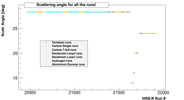Phone Meeting: HRS-R Analysis (03/05/2009)
I have returned to my original problem - determination of the beam energy. In my prior analysis I have been
using mostly data from HRS-L because of the Dipole magnet problem in the HRS-R. The problem with this analysis
was that I had too many variables to fit, because everything was changing: beam energy, scattering angles, and
central momenta of the spectrometer. Therefore I had to "invent" some constraints to reduce the number of free
parameters. Unfortunately the assumptions that I have used were wrong.
Now I have decided to concentrate my analysis on the HRS-R data from the region where its dipole magnet was stable. Since HRS-R was set the whole run period to the same momentum I have only one central momentum to determine. Because of that I don't need additional constrains in my fitting procedure.
Following graphs show how scattering angle and target type change with the run number:
1.)  2.)
2.)
For starters I have decided to make a bit simpler analysis. I have written scripts which automatically analyze runs and determine the positions of the maximum of the elastic peak. This method is not very accurate because of the statistical errors (\Delta \delta approx 0.002 => 0.7MeV ), but I intend to make it more reliable (i.e. Fitting a Gaussian peak). With this analysis I would also like to determine more precisely how real energy changes with the Tiefenbach energy and perhaps try to determine if the momentum of the HRS-R is really as stable as the Hall probe says.
Here are some preliminary results of my analysis. So far I was able to analyze only Carbon 7-foil runs
and some Hydrogen runs:
Automatic Carbon run analysis
Automatic Hydrogen run analysis
After I determined positions of maxima for all elastic peaks I was able to make plot of delta(scat. angle) and finally tried to fit the beam energy.

 2.)
2.)
